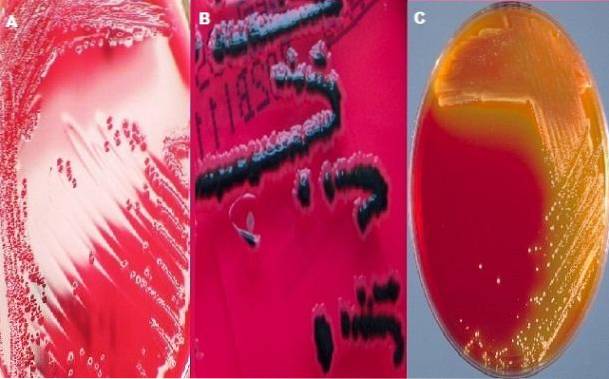
XLD agar rationale, preparation and uses
The XLD agar or Xylose Lysine Deoxycholate Agar is a selective and differential solid culture medium for the isolation of enteropathogens. Taylor designed the XL agar formula (Xylose, Lysine) in order to improve the isolation of the genus Shigella.
He observed that this genus was inhibited in most media intended for the isolation of enteropathogens. Subsequently, sodium deoxycholate, sodium thiosulfate and ferric ammonium citrate were added to increase its selectivity. This formula has proven to be useful for the isolation of both Shigella and Salmonella.

XLD agar is composed of yeast extract, sodium deoxycholate, xylose, lysine, lactose, sucrose, sodium thiosulfate, ferric ammonium citrate, sodium chloride, phenol red and agar. In most bacteriology laboratories XLD agar and SS agar are used to study fecal samples for Shigella and Salmonella..
Other laboratories prefer the combination of CHROMagar Salmonella and XLD agar, among other available options. These duos can be prepared in double Petri dishes. On one side they place XLD agar and on the opposite side the other chosen medium.
Article index
- 1 Rationale
- 1.1 -Nutritive power
- 1.2 -Selectivity of the medium
- 1.3 -Differential power
- 1.4 -Sodium chloride, agar and phenol red
- 2 Preparation
- 3 Uses
- 3.1 Types of samples
- 3.2 Sowing and identification conditions
- 4 Quality control
- 5 Final considerations
- 6 References
Basis
-Nutritive power
XLD agar has yeast extract, which serves as a source of nutrients for the microorganisms that develop on this agar. In addition, the presence of carbohydrates (xylose, sucrose and lactose) provide energy to the bacteria that can ferment them.
-Selectivity of the medium
As an inhibiting substance, it has sodium deoxycholate; This prevents the growth of Gram positive bacteria, making the medium selective.
-Differential power
Typical Shigella colonies
As already mentioned, XLD agar contains xylose; This carbohydrate is fermented by all bacteria that grow in this medium except for the Shigella genus..
This is one of the characteristics that gives it its differential character, since the Shigella colonies are distinguished from the rest by developing red colonies, while the other bacteria produce yellow colonies.
Typical colonies of Salmonella
The genus Salmonella also ferments xylose, initially generating yellow colonies. However, after depleting the carbohydrate xylose, it attacks lysine for its enzyme lysine decarboxylase. The decarboxylation of lysine generates alkalis that turn the color of the colony and the surrounding medium to the original red..
This behavior is only carried out by Salmonella, since the coliforms that decarboxylate lysine cannot alkalize the medium. This is because coliforms also ferment the lactose and sucrose present; therefore, the production of acids is very high, leaving the yellow colony in these bacteria.
It should be noted that the genus Salmonella does not ferment sucrose or lactose.
Production of HtwoS
XLD agar also allows the detection of Salmonella species that produce HtwoS; For this, it relies on the source of sulfur represented by sodium thiosulfate and a reaction developer, which is ferric ammonium citrate..
The latter reacts with the HtwoS (colorless gas) and forms an insoluble visible black precipitate of iron sulfate. In this sense, the characteristics of the salmonella colonies will be red with a black center..
It should be noted that for the formation reaction of HtwoYes, an alkaline pH is needed. That is why other Enterobacteriaceae that form HtwoS they cannot do it or they do it poorly in this medium, because the high acidity that they produce when fermenting the carbohydrates present inhibit or hinder the reaction.
-Sodium Chloride, Agar, and Phenol Red
Finally, sodium chloride maintains osmotic balance; agar is the solidifying agent and phenol red detects changes in pH, turning the color of the colonies and the medium.
Preparation
Weigh out 55 g of dehydrated XLD medium and dissolve in 1 liter of water. Heat and stir the mixture until it reaches the boiling point. Do not overheat, as heat damages the medium and creates a precipitate that alters the morphology of typical colonies.
This medium must not be autoclaved. When dissolving, it must be passed to a water bath at 50 ° C. When cooling it should be served directly on sterile Petri dishes. They can be poured into single plates or double plates. They are left to solidify and stored in the refrigerator until use..
Temper before use. As it is a non-sterile medium, it is recommended to prepare it close to the date of use..
The final pH of the medium should be 7.4 ± 0.2. The color of the prepared medium is orange-red, translucent, without precipitate..
If you have Xylose Lysine (XL) base agar, you can add sodium deoxycholate, sodium thiosulfate and iron ammonium citrate. In this way, the XLD agar formula is obtained..
Applications
XLD agar is used for the recovery of enteropathogens, mainly of the genus Shigella and secondarily of the genus Salmonella. It is useful for evaluating stool, water and food samples.
Types of samples
Feces
Stool samples can be sown directly on XLD agar, making a good distribution of the material to obtain isolated colonies.
To improve Salmonella recovery, XLD agar can be sown from Salmonella enrichment media..
Food
In the case of food, enrichment broths for Salmonella and Shigella can be used. For Salmonella you can use selenite cystine broth, bright green tetrathionate broth, among others..
In the case of Shigella, it can be enriched with Shigella broth with 0.5 µ / ml of novobiocin, incubated at 42 ° ± 1 ° C for 16-20 hours.
Water
In water analysis, the membrane filtration technique and the use of XLD agar are recommended, among others..
Planting and identification conditions
The seeded medium is incubated aerobically at 35 ° C for 24 to 48 hours..
The typical colonies of each genus are observed, the suspicious colonies should undergo biochemical tests for their identification.
QA
The following bacterial strains can be used to evaluate the quality control of the medium: Salmonella typhimurium ATCC 14028, Salmonella enteritidis ATCC 13076, Salmonella abony DSM 4224, Shigella flexneri ATCC 12022, Shigella sonnei ATCC 25931, Escherichia coli ATCC 25922, Proteus mirabilis ATCC 43071, Klebsiella pneumoniae ATCC 33495.
The genus Salmonella is characterized by presenting in this medium red colonies with a black center or completely black colonies. Whereas, in the genus Shigella, the colonies must be red, that is, the color of the medium..
In the case of Escherichia coli it is expected to be totally or partially inhibited; if it grows the colonies are yellow. In order to Proteus mirabilis poor growth is expected with pink colonies with or without a black center. Eventually the genus Klebsiella will grow as yellow colonies.
Final thoughts
XLD agar is widely used in bacteriology laboratories due to its high efficiency for the recovery of Shigella and also has a good recovery of the Salmonella genus.
Rall et al. (2005) in their work entitled "Evaluation of three enrichment broths and five solid media for the detection of Salmonella in poultry" demonstrated that of the 3 classic media tested (bright green agar, SS agar and XLD agar) , XLD agar had the best recovery rate.
The recovery percentages were as follows: 13.8% for bright green agar, 27.6% for SS, and 34.5% for XLD. It was only surpassed by the chromogenic media Rambach agar with 48% recovery and the CHROMagar with 79.3%.
References
- Foodborne illnesses. Shigellosis. Available at: anmat.gov.ar
- "XLD agar." Wikipedia, The Free Encyclopedia. 9 Feb 2019, 11:46 UTC. 10 Apr 2019, 19:25 wikipedia.org
- BBL Laboratories. CHROMagar Salmonella / BD XLD Agar (biplate). 2013 Available at: bd.com
- Lab. Neogen. XLD agar. Available at: foodsafety.neogen
- Francisco Soria Melguizo Laboratory. XLD Agar. Available at: http://f-soria.es/Inform
- Rall L, Rall R, Aragon C, Silva M. Evaluation of three enrichment broths and five plating media for Salmonella detection in poultry. Braz. J. Microbiol. 2005; 36 (2): 147-150. Available from: scielo.br
- Forbes B, Sahm D, Weissfeld A. (2009). Bailey & Scott Microbiological Diagnosis. 12 ed. Editorial Panamericana S.A. Argentina.



0ypkZ0YK3AcHeSve0L0G3B3UA4VcjP9pHVqJwSF6e9JiXWhRUa6309CwIiswENP4dUpFRXTA1x6U6ojp3egAZtO96TWEwtdWJBdUDTtcmA9O8RZJfMb9bLeRk1VJbwhXbfSsyXVvTM